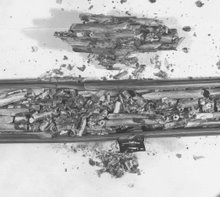It was a good thing that I was at the operating station about 53 years ago at National Reactor Testing Station (NRTS) in the desert near Idaho Falls, Idaho. The Materials Testing Reactor (MTR) was about a year or so in operation and I had the job of installing and starting up the first pressurized water loop in the MTR for prototype Nautilus fuel. With about three years of solid engineering experience in the nuances of in-pile testing, I inherited this job somewhat by default. The Nautilus was running as well as prototype reactors in the Idaho desert, so why test prototype fuel? However, the project was underway when I went to work at Argonne National Laboratory near Chicago during November 1952 and testing of the prototype fuel proceeded by inertia.
We completed fabrication and crude shakedown testing of the loop at Argonne, Chicago, and shipped the gear to NRTS. With expert assistance and design improvement by key personnel from Phillips Petroleum Company, the operating contractor for MTR, installation and startup of the equipment proceeded in record time. So the loop was operating with the prototype Nautilus fuel in place, when I had my baptism in managing an accident. A 1/4 inch diameter sensing line at the main flow metering orifice severed and blow down from 2500 PSI and 570 degrees F. began. I was at the control panel and the first indication of trouble was a loss of flow signal that let to switching of the primary pump to a standby pump, followed immediately by a scram (fast shutdown) of the MTR.
I very quickly knew where the break was, and I knew that it could not be isolated. I decided that the best approach would be to allow the primary pumps to automatically shift from A to B to C and back to A, etc., as the blowdown proceeded. An option would have been to turn off the pumps, but that would have led to a real loss of cooling for the prototype Nautilus fuel while it still had a relatively high level of decay heat. Of course, this option was not an option forever. At some point, the pressurizer would be empty and voiding and real loss of flow would quickly follow.
My first step was to turn on a low capacity piston pump that delivered about one gallon per hour to the loop. I valved this flow to the liquid level reference sensing standpipe for the pressurizer. I knew that the loop was operating with a concentration of dissolved hydrogen for corrosion control. I also knew that the cold reference sensing line acted as a cold thumb and the the hydrogen concentration on the standpipe would be at saturation for 2500 PSI and its temperature of under 100 degrees F. And I knew that as pressure was reduced during blowdown the hydrogen would begin to outgas in the standpipe and that water would thus be bubbled out of the standpipe. The liquid level signal would then be false and the pressurizer would be empty even though the instrumentation would indicate otherwise. I also knew that the modest flow into the standpipe would not upset the accuracy of the calibration of the level sensing system.
So, I allowed the loop to blow down and depressurize, and as the level approached 10 percent of full, in quick order I proceeded as follows: I turned off the primary pumps. Next, with assistance from Fred McMillan of Phillips Petroleum Company, I isolated the in-pile pressure tube assembly from the main loop (two valves) and then opened the cooling of the in-pile assembly to once-through cooling by process water (two more valves).
Of course, it is not always great for one's career to be on the scene of an accident. And it makes little difference if one's moves were somewhat lifesaving. A few months later I was back at the home office at Argonne, Chicago. At one point I was asked what good I thought a gallon per hour of injected flow would do in the blowdown situation. Well, I did not answer.
Decades later, the value of a degassed reference standpipe (or the safety problem with a hydrogen saturated standpipe) was not recognized by some very highly paid consultants as well as the equipment suppliers of huge nuclear power plants.
 Lightning is covered in several entries in my other blog, http://nuclearpowerblog.blogspot.com/.
Lightning is covered in several entries in my other blog, http://nuclearpowerblog.blogspot.com/. 










